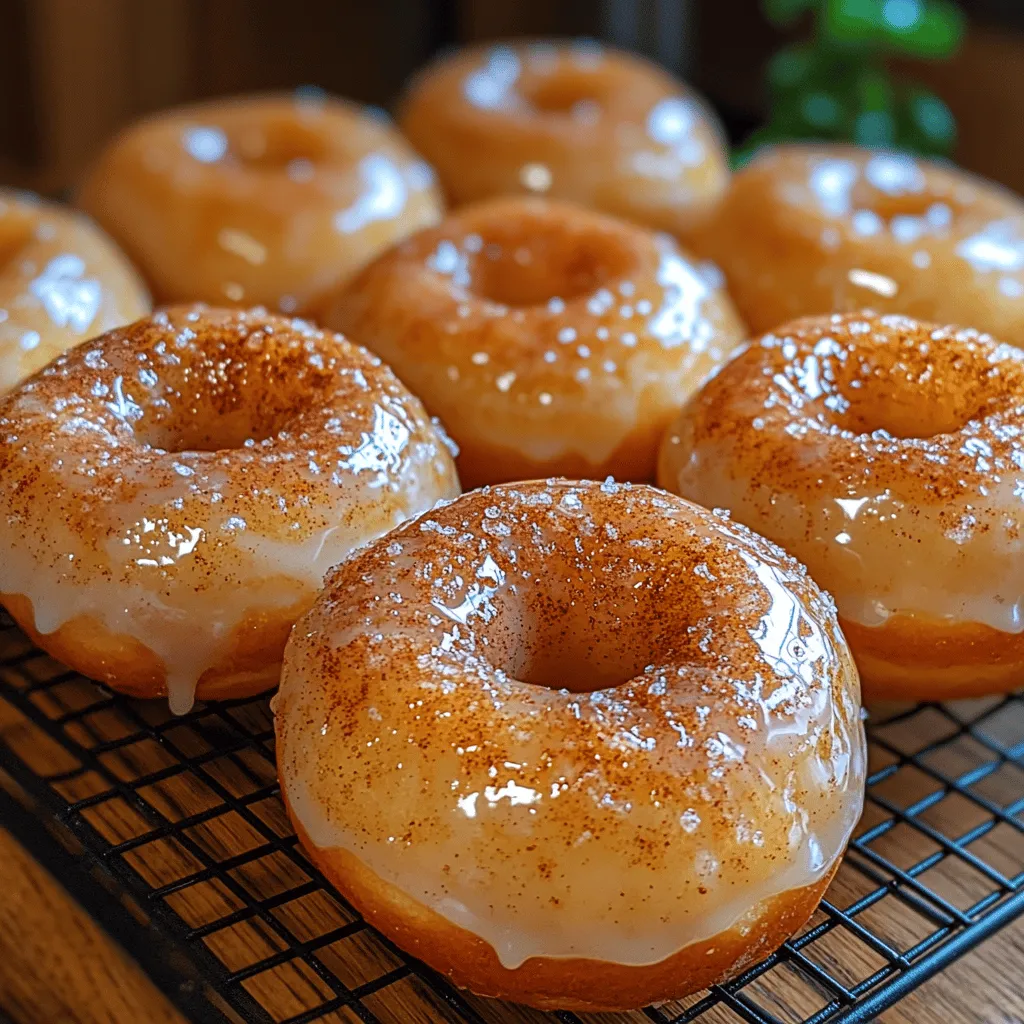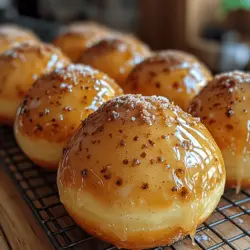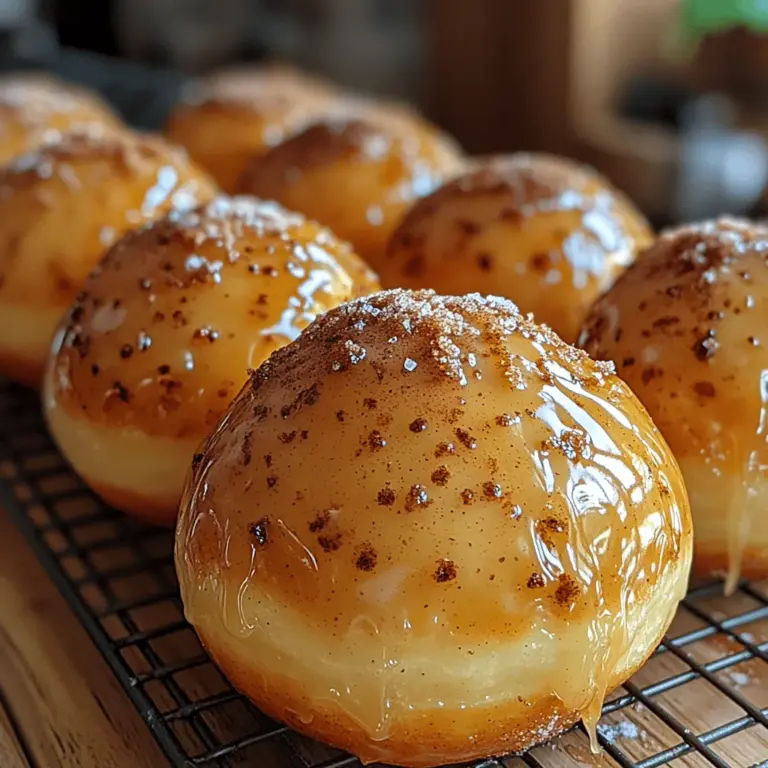Introduction
Donut holes are a delightful treat that has captivated taste buds across the globe, and the Sweet Maple Glazed Donut Holes take this beloved snack to a whole new level. These bite-sized morsels of joy are characterized by their soft, fluffy texture and a sweet maple glaze that adds a luscious finish. Whether enjoyed as a breakfast indulgence, a midday snack, or a dessert, these donut holes are versatile and perfect for any occasion.
The origins of donut holes can be traced back to the classic American donut, which has a rich history in various cultures. The concept of frying dough to create sweet treats can be found in many culinary traditions, but it was in the United States that donuts evolved into the beloved form we know today. The donut hole, a small ball of dough that is typically made from the excess dough cut out of traditional ring donuts, has become a staple in bakeries and homes alike.
Cultural significance aside, the Sweet Maple Glazed Donut Holes stand out not only because of their delightful flavor but also due to the simplicity of their ingredients. This recipe highlights the importance of using quality components to achieve the best results. The star of the show is, of course, the maple syrup, which infuses the glaze with a rich sweetness that perfectly complements the tender donut holes.
Understanding the Key Ingredients
To create the perfect batch of Sweet Maple Glazed Donut Holes, it’s essential to understand the key ingredients involved in the recipe. Each component plays a vital role in developing the flavor and texture that makes these treats irresistible.
– All-Purpose Flour: As the base of the donut holes, all-purpose flour provides the structure necessary for fluffy and light donut holes. Choosing the right flour ensures that the dough has the proper consistency to absorb the glaze without becoming overly soggy.
– Granulated Sugar: This ingredient not only sweetens the donut holes but also contributes to their golden-brown color when fried. The sugar helps create a slight crust, enhancing the overall texture and flavor.
– Baking Powder: A crucial leavening agent, baking powder helps the donut holes rise, giving them their characteristic lightness. It’s essential to use a fresh batch of baking powder for optimal results, as expired leavening agents can lead to dense and heavy treats.
– Milk: Milk adds moisture to the dough, resulting in a soft texture. Whole milk is recommended for its richness, but alternatives like almond milk or oat milk can be used for those with dietary restrictions.
– Eggs: Eggs provide structure and richness to the donut dough, contributing to its flavor and texture. They also act as a binding agent, ensuring that the ingredients come together smoothly.
– Maple Syrup: The star ingredient of this recipe, maple syrup, brings a distinct flavor that elevates the donut holes. Real maple syrup is preferred for its authenticity and depth of flavor, but pancake syrup can be used in a pinch if necessary.
– Vegetable Oil: Used for frying, vegetable oil should have a high smoke point to ensure the donut holes cook evenly without absorbing too much oil. Canola oil or peanut oil are great options for frying.
– Powdered Sugar: This ingredient is used to create the sweet maple glaze. The fine texture of powdered sugar blends seamlessly with maple syrup, allowing for a smooth and glossy finish on the donut holes.
The Traditional Cooking Method
Creating the perfect Sweet Maple Glazed Donut Holes is a process that involves several key steps. Understanding the traditional cooking methods will help you achieve the best results and ensure that your donut holes are fluffy, flavorful, and perfectly glazed.
1. Preparing the Dough
Start by gathering all your ingredients and tools. In a large mixing bowl, combine the all-purpose flour, granulated sugar, baking powder, and a pinch of salt. Whisk these dry ingredients together until they are well mixed. This step is crucial as it ensures an even distribution of the leavening agent, which is essential for achieving a light texture in your donut holes.
In a separate bowl, whisk together the milk, eggs, and a splash of vanilla extract for added flavor. Once combined, gradually pour the wet mixture into the bowl with the dry ingredients. Using a wooden spoon or a spatula, gently fold the mixture until just combined. Be careful not to overmix; a few lumps are perfectly acceptable. The goal is to create a soft dough that is not too sticky.
2. Shaping the Donut Holes
Once your dough is prepared, it’s time to shape the donut holes. Lightly flour your work surface to prevent sticking, and turn out the dough onto the floured surface. Using your hands, gently pat the dough into a rectangle about 1 inch thick. Using a round cookie cutter or a small glass, cut out circles from the dough. Gather any scraps and re-roll to cut out additional donut holes.
If you want to create a more uniform shape, you can roll small portions of dough into balls, about 1 inch in diameter. This method allows for a more rustic look but ensures that every donut hole is perfectly bite-sized.
3. Heating the Oil
Next, it’s time to heat the oil for frying. In a deep saucepan or a heavy skillet, pour in vegetable oil to a depth of about 2-3 inches. Heat the oil over medium-high heat until it reaches 350°F (175°C). Use a kitchen thermometer to monitor the temperature, as maintaining the right heat is crucial for frying.
If you don’t have a thermometer, you can test the oil by dropping a small piece of dough into the hot oil. If it sizzles and rises to the surface, the oil is ready for frying. Always be cautious when working with hot oil to avoid any burns or accidents.
4. Frying the Donut Holes
Carefully drop a few donut holes into the hot oil, ensuring not to overcrowd the pan. Fry them for about 2-3 minutes on each side, or until they are golden brown. Using a slotted spoon, gently turn the donut holes to ensure even cooking. Once they are cooked to perfection, remove them from the oil and place them on a paper towel-lined plate to drain excess oil.
Frying in batches will help maintain the oil temperature, ensuring that your donut holes cook evenly and thoroughly. As you fry, watch for any signs of smoking oil, which indicates that the temperature is too high. Adjust the heat as needed to maintain a steady frying temperature.
5. Preparing the Sweet Maple Glaze
While the donut holes are cooling, it’s time to make the sweet maple glaze. In a medium bowl, sift the powdered sugar to remove any lumps. Gradually add maple syrup while whisking until you achieve a smooth, pourable consistency. If the glaze is too thick, add a little more maple syrup or a splash of milk to thin it out.
For an extra touch, you can also add a pinch of salt to balance the sweetness and enhance the maple flavor. Mixing the glaze to perfection ensures that it adheres beautifully to the warm donut holes, creating a glossy finish.
In the next section, we will delve deeper into the final steps of glazing the donut holes and share tips for achieving the best results, along with some variations to consider for those looking to experiment with flavors. Stay tuned for more delicious insights on creating the perfect Sweet Maple Glazed Donut Holes!

Adding Vegetables: Creative Twists to the Classic Recipe
While traditional Spaghetti Carbonara is a beloved classic, adding vegetables can enhance both flavor and nutrition, making the dish even more appealing. Consider incorporating sautéed spinach, which adds a vibrant green color and a slight earthy flavor. Alternatively, roasted zucchini or bell peppers can offer a hint of sweetness and a satisfying texture. For those who enjoy a bit of crunch, finely chopped broccoli or peas can be mixed in right before serving, introducing a fresh component to the creamy pasta.
Another inventive twist is to incorporate sun-dried tomatoes, which provide a burst of tangy flavor that contrasts beautifully with the rich sauce. If you’re seeking a hearty option, mushrooms can be sautéed alongside the pancetta, lending an umami depth to the dish. With these creative additions, you can customize your Carbonara to suit your tastes while still honoring its traditional roots.
Common Mistakes to Avoid
When preparing Spaghetti Carbonara, several common pitfalls can detract from the dish’s authentic flavor and texture. Here are key mistakes to avoid:
– Overcooking the Pasta: One of the most critical aspects of a perfect Carbonara is achieving al dente pasta. Cooking it just right ensures that the pasta retains a slight bite, enhancing the dish’s overall texture. Be sure to taste the pasta a minute or two before the package instructions suggest, as it will continue to cook slightly when mixed with the hot sauce.
– Using Cream: A prevalent misconception is that Carbonara requires cream for its sauce. Authentic Carbonara relies solely on eggs and cheese to create a rich, silky texture. Adding cream not only alters the flavor but also masks the unique taste of the cheese and eggs, resulting in a less authentic dish.
– Incorrect Temperatures: The temperature at which you combine the egg mixture with the pasta is crucial. If the pasta is too hot, it will scramble the eggs, resulting in a grainy texture. Conversely, if it’s too cool, the sauce won’t emulsify properly. Aim for a slightly cooled pasta that is still warm to the touch when mixing in the egg mixture to achieve that creamy consistency.
– Skipping the Pepper: Freshly cracked black pepper is not just an afterthought; it’s an essential component that enhances the dish’s overall flavor. The pepper’s sharpness counterbalances the richness of the egg and cheese, creating a harmonious blend of flavors. Do not skimp on this ingredient; it truly elevates the dish.
Serving Suggestions
To appreciate the full experience of Spaghetti Carbonara, consider these serving suggestions:
– Traditional Accompaniments: Classic Italian meals often include a simple side salad dressed with olive oil and vinegar, which provides a refreshing contrast to the rich pasta. Garlic bread or bruschetta can also be a delightful accompaniment, perfect for soaking up any leftover sauce.
– Wine Pairings: When it comes to wine, a crisp white such as Pinot Grigio or a light red like Chianti pairs beautifully with Carbonara. The acidity in these wines complements the richness of the dish, enhancing your dining experience.
– Presentation Tips: A visually appealing plate can elevate your Carbonara from simple to extraordinary. Consider serving it in a shallow bowl to highlight the creamy sauce. Garnish with a sprinkle of freshly grated Pecorino Romano cheese and a dash of cracked black pepper. Adding a sprig of fresh parsley can introduce a pop of color and freshness, making the dish even more inviting.
Nutritional Benefits of Spaghetti Carbonara
Understanding the nutritional profile of Spaghetti Carbonara can help you enjoy this dish mindfully while still appreciating its indulgence.
– Understanding the Nutritional Profile: Traditional Carbonara contains key ingredients that provide various nutrients. The eggs are an excellent source of protein, while the cheese adds calcium and additional protein. The pasta offers carbohydrates, which are essential for energy, especially if you’re preparing for a long day.
– Balancing Indulgence with Health: While Carbonara is undoubtedly rich, practicing portion control is vital. Consider serving smaller portions alongside a hearty salad to create a balanced meal. This approach allows you to enjoy the flavors without overindulging.
– The Role of Quality Ingredients: The quality of your ingredients plays a significant role in the dish’s nutritional value. Opt for high-quality pasta, organic eggs, and artisanal cheese whenever possible. These choices not only enhance flavor but also provide better nutritional benefits compared to lower-quality alternatives.
Cultural Impact and Popularity of Carbonara
Spaghetti Carbonara has transcended its origins in Rome to become a staple in kitchens around the world. Its rise in global cuisine showcases the dish’s versatility and appeal.
– The Rise of Carbonara in Global Cuisine: In recent years, Carbonara has gained immense popularity in various countries, often being featured on restaurant menus and in cooking shows. Its simplicity and flavor have made it a go-to for both home cooks and professional chefs alike.
– How the Dish Has Been Adapted in Various Countries: Different cultures have embraced Carbonara, adding their unique twists. For instance, in the United States, you might find variations that include chicken or even seafood. These adaptations, while divergent from the original recipe, demonstrate the dish’s flexibility and the creativity of home cooks.
– The Role of Social Media in Popularizing Italian Recipes: Platforms like Instagram and TikTok have played a crucial role in the resurgence of interest in traditional Italian dishes. Food bloggers and chefs share their interpretations of Carbonara, often showcasing visually stunning plates that inspire viewers to recreate the dish at home. This social media influence has helped bridge the gap between authentic recipes and modern adaptations.
Conclusion
In conclusion, Spaghetti Carbonara stands as a testament to the beauty of simplicity in Italian cuisine. Its rich flavors, creamy texture, and satisfying ingredients make it a beloved choice for many. By adhering to authentic preparation methods and avoiding common mistakes, you can create a dish that honors its traditional roots while allowing for personal touches through the addition of vegetables or alternative ingredients.
As you explore the world of Carbonara, remember the importance of quality ingredients and mindful eating. Whether you’re enjoying it as a comforting weeknight dinner or impressing guests at a dinner party, this classic dish remains a timeless favorite. Embrace the flavors of traditional Italian cooking and let Spaghetti Carbonara transport you to the heart of Italy with each delicious bite.

